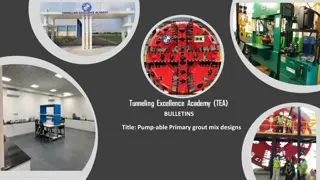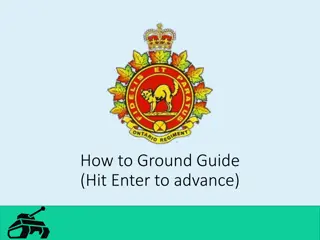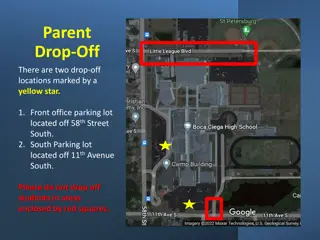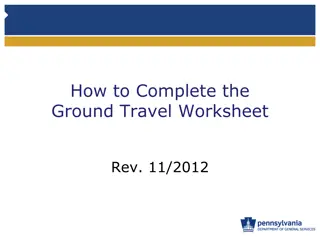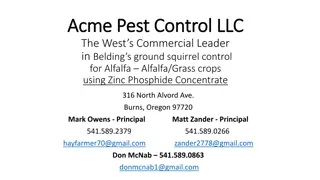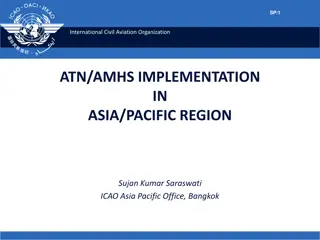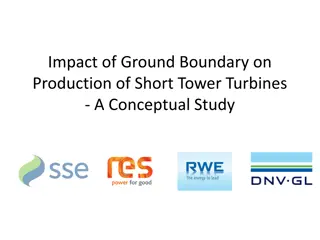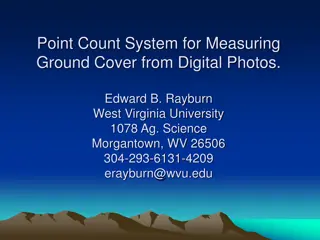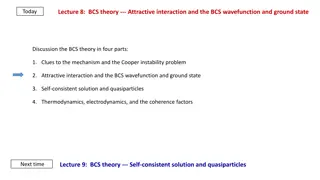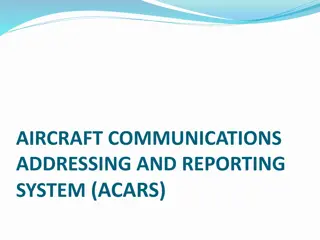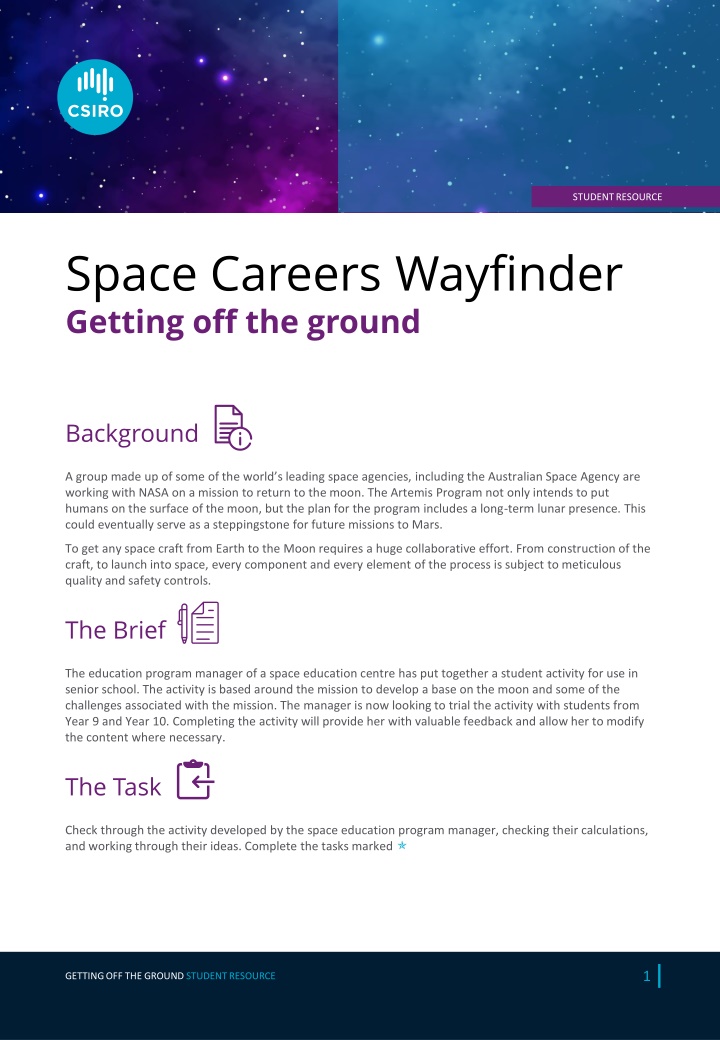
Exploring Space: Calculations and Analysis in Lunar Missions
Delve into the intricacies of space exploration through calculations and analysis in a student activity centered around lunar missions. From determining escape velocities to assessing acceleration rates of iconic missions like Apollo 11, this resource provides an engaging way to understand the challenges and dynamics of venturing beyond Earth's atmosphere. Additionally, compare data from historic launches like Apollo 11 to modern ventures like SpaceX's Falcon 9 to witness the evolution of space technology.
Download Presentation

Please find below an Image/Link to download the presentation.
The content on the website is provided AS IS for your information and personal use only. It may not be sold, licensed, or shared on other websites without obtaining consent from the author. If you encounter any issues during the download, it is possible that the publisher has removed the file from their server.
You are allowed to download the files provided on this website for personal or commercial use, subject to the condition that they are used lawfully. All files are the property of their respective owners.
The content on the website is provided AS IS for your information and personal use only. It may not be sold, licensed, or shared on other websites without obtaining consent from the author.
E N D
Presentation Transcript
STUDENT RESOURCE Space Careers Wayfinder Getting off the ground Background A group made up of some of the world s leading space agencies, including the Australian Space Agency are working with NASA on a mission to return to the moon. The Artemis Program not only intends to put humans on the surface of the moon, but the plan for the program includes a long-term lunar presence. This could eventually serve as a steppingstone for future missions to Mars. To get any space craft from Earth to the Moon requires a huge collaborative effort. From construction of the craft, to launch into space, every component and every element of the process is subject to meticulous quality and safety controls. The Brief The education program manager of a space education centre has put together a student activity for use in senior school. The activity is based around the mission to develop a base on the moon and some of the challenges associated with the mission. The manager is now looking to trial the activity with students from Year 9 and Year 10. Completing the activity will provide her with valuable feedback and allow her to modify the content where necessary. The Task Check through the activity developed by the space education program manager, checking their calculations, and working through their ideas. Complete the tasks marked 1 GETTING OFF THE GROUND STUDENT RESOURCE
The Student Activity Earth s gravity is what prevents us from floating off the planet. For any object to escape the pull from Earth s gravity and explore deep space scientists have calculated it would need to reach a velocity of 11.2 km/s or 40 243 km/h. Use the following formula and information to prove, or disprove the above velocity value: Formula: Ve = 2GM r G = 6.674 x 10-11m3kg-1s-2 (Newton s universal Ve (m/s) = Escape Velocity from Earth M = 5.972 1024kg (mass of planet leaving from [Earth]) constant of gravity) r = 6.378 106m (radius of planet [Earth]) What would your value be in km/h? The gravitational constant g is a measure of acceleration due to gravity. The force we experience on the surface of the Earth is equal to 1g. Astronauts aboard the Apollo 11 mission to the moon experienced up to 4.5 g, during take-off. Using the Apollo 11 launch footage (https://www.youtube.com/watch?v=Vg9WolsXbIA) slowed to 0.5 normal speed. Record the time and velocity of the launch every 5 seconds from take-off (0 seconds) to 60 seconds, plot your recordings and answer the following: Velocity (m/s) Time (s) 0 5 10 15 20 25 30 35 40 45 50 55 60 2 GETTING OFF THE GROUND STUDENT RESOURCE
1. What can you say about Apollo 11 acceleration for the first 60 seconds? 2. What is the rate of acceleration between 50 seconds and 60 seconds? 3. Using the g Force formula (below) what would be the approximate g force experienced by the astronauts for the 10 seconds between 50 seconds and 60 seconds after launch? (NOTE g force would need to be greater than 1 g or the rocket wouldn t be able to leave the surface) Where: v1 = velocity at 60 seconds v0 = velocity at 50 seconds t = time g = acceleration due to gravity (9.81 m/s2) g force = V1 V0 tg SpaceX is a spacecraft manufacturer, launcher, and a satellite communications corporation based in the US. At the core of their spacecraft fleet is the Falcon 9 rocket. Unlike previous space craft, the Falcon 9 is a reusable rocket, and in January 2023 SpaceX used one of their Falcon 9 rockets on its 15th mission. The approximate velocity data below was collected from the live broadcast of the January 2023 launch1 Time (s) 0 5 10 15 20 25 30 35 40 45 50 55 60 Velocity (m/s) 0 9 29 52 76 103 132 162 196 231 251 275 317 Plot the Falcon 9 velocity and time data on your plot of the Apollo 11 velocity vs time plot. 1 Use this Space X clip: https://www.youtube.com/watch?v=lSRXacd8wU8 3 GETTING OFF THE GROUND STUDENT RESOURCE
4. Calculate the approximate rate of acceleration for Falcon 9 between 45 to 50 seconds and then between 55 to 60 seconds. What can you say when comparing these two periods during the rocket s acceleration? 5. Which of the two rockets, Apollo11 and Falcon 9 has the greater rate of acceleration? The Payload contents of a rocket vary depending on the mission. The International Space Station for example, required around 40 missions transporting items ranging from crew living quarters to food and toiletries. Payload costs have reduced over the years from around $65 0002 per kilogram during the space shuttle era, to around $2500 per kilogram using SpaceX s Falcon Heavy rocket. The payload ratio of a rocket is the maximum payload of the spacecraft divided by the weight of the propellant and non-fuelled spacecraft, and is given the symbol lambda ( ) where: md = payload mass mp = total mass of propellant (fuel) ms = mass of the spacecraft including empty tanks and boosters (not including payload mass and propellant mass) = md / (mp + ms) Use the following information to determine the approximate payload mass for a space shuttle mission to Low-Earth Orbit (LEO) if the shuttle has a payload ratio of 1.25% https://publicdomainvectors.org/ photos/Space-Shuttle.png 2 https://ourworldindata.org/grapher/cost-space-launches-low-earth-orbit 4 GETTING OFF THE GROUND STUDENT RESOURCE
As of early 2023 SpaceXs Falcon 9 rocket used on Falcon Heavy is the most powerful rocket in use. As a result of advances in materials and rocket technology along with SpaceX s ability to recover and reuse the Falcon 9 rockets, they are able to offer a very competitive launch service to space. How does Falcon 9 s payload ratio for a LEO launch compare with the approximate payload ratio of 1.25% for a shuttle launch? Falcon 9 statistics: ms = 72 300 kg mp = 1 338 500 kg md = 63 800 kg In 2018 SpaceX launched a car into space. Assuming the car, a Tesla Roadster (1235 kg) launched aboard a Falcon Heavy rocket wasn t modified in any way and the Starman mannequin added 40 kg to the cars weight. What percentage of the payload mass was the car? And how many Tesla Roadsters with mannequins could they have launched? If the Falcon Heavy was to be used for a mission to the Moon the payload mass would reduce to around 20 000 kg due to the extra fuel needed. If 2.5% of this was taken up with seating for 10 astronauts and the average weight per astronaut was 78.5 kg. What would be the remaining payload capacity if 10 astronauts were on a Moon mission? With a higher payload ratio than many of their competitors and the ability to reuse the first stage booster of the Falcon 9 rocket SpaceX have an advantage over many of their competitors. Safely landing the booster required numerous attempts until the first successful landing in 2015 (https://www.youtube.com/watch?v=p9FzWPObsWA) 5 GETTING OFF THE GROUND STUDENT RESOURCE
Extension question If the first stage booster rocket was released at a height of 80 km and fell vertically to Earth. Approximately how long would it take the booster rocket to reach the earth s surface, if the boosters freefall terminal velocity was 450 m/s and the booster accelerated at 9.8 ms2 until it reached terminal velocity? NOTE We are assuming air resistance is negligible and terminal velocity was 450 m/s STEP 1 Determine time taken to reach terminal velocity using v = u + at Where: v= final velocity (in this case, 450 m/s) t = time taken a = acceleration (9.8 m/s2) u = initial velocity (0 m/s since we are starting from rest) STEP 2 Determine distance travelled up to reaching terminal velocity using dinitial = at2 Where: d = initial distance (m) STEP 3 Determine distance travelled at terminal velocity (dterminal): dtotal dinitial STEP 4 Determine time taken to travel 69 631.6m at 450 m/s using t = d / v Total time taken for the booster to reach the surface = time during acceleration + time during terminal velocity 6 GETTING OFF THE GROUND STUDENT RESOURCE SPACE CAREERS WAYFINDER IS A COLLABORATION BETWEEN THE CSIRO AND THE AUSTRALIAN NATIONAL UNIVERSITY





